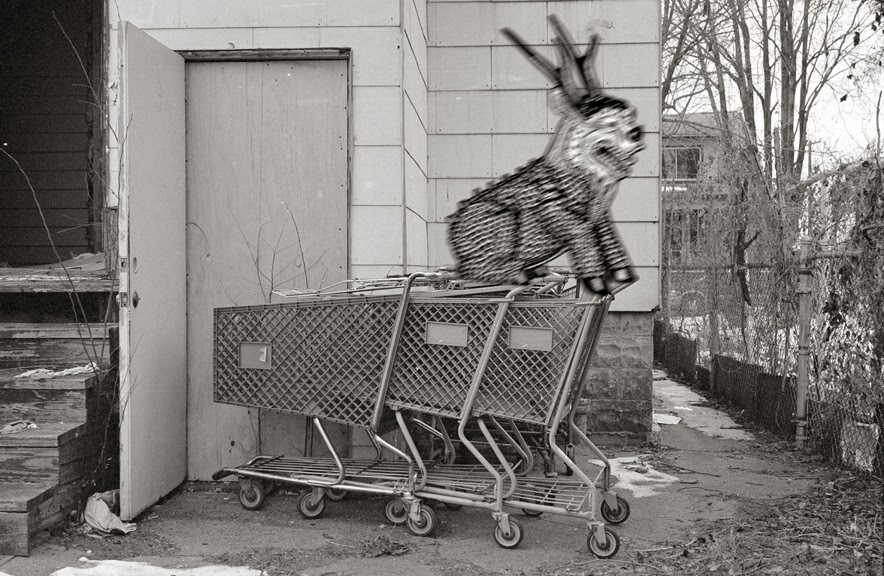 | ||
| Mitch Cope, Scrap-a-House, 2014. Archival ink jet print. (All images by Mitch Cope; courtesy of the artist.) |
The exhibition consists of seven large-scale black-and-white photographs originally shot on 35mm negatives and digitally transferred.There are also two installation pieces, one of which included a video done under the auspices of Design 99.The photographs document the stockpiles of refuse that litter the neighborhood in which Cope and Reichert work and the installations use some of that material in their construction. The photographs assiduously document every bit of refuse appearing within the frame in the manner of an archeologist taking inventory of every shard of material culture uncovered at a dig site. (Example: Eddy's Pile, 2014: "1 shopping cart with vacuum parts, various Jeep car parts, 1 kid's push car, 3 black sofas, 1 cushy chair, 1 stool, 1 dresser, 2 baby mattresses, 1 playpen, assorted garbage, boys and girls clothing, various plastic bins, paperwork, miscellaneous VHS tapes, several yogurt cups, 1 TV.") The installations works are equally precise in their documenting of their components.
 |
| Steve's Pile, 2014. Archival ink jet print. |
The installations seemingly focus more directly on the physical artifact. Scrap-a-House Totem, 2014, set five interlocking shopping carts on end, reaching up to the ceiling, atop of which sat a charred recliner and a rocker held in place with a ratchet strap. The installation of a wing back chair set on linoleum flooring and truck tire for Garbage Totem #1: Clearing a Path to the Future, 2011, was actually constructed so as to provide a perch from which to view a 20-minute video documenting the retrieval of castoff mattresses from around the neighborhood and their installation on a dead pine tree spike in an exercise of repurposing the refuse of life into the refuge of art.
In both instances, the reference to the totem is formal, a description of the stacking procedure. And yet at the same time it gestures toward a mythopoetic understanding of the totem that, as anthropologist Claude Levi-Strauss (who also gave us the useful concept of bricolage*) suggests, might serve to help make comprehensible the disconnect between the natural and the social worlds. In this case, what one might see as the disconnect is the failed promise of the profit motive, the so-called invisible hand, and its ruinous effects as witnessed on the ground in Banglatown and elsewhere in Detroit.
Design 99, Garbage Totem #1: Clearing a Path to the Future, 2011. (5-minute excerpt of a 20-minute video.)
* The practice of bricolage by the avant-garde in the form of Cubist collage and the Dadaist readymade predates by several decades Levi-Strauss's use of the term in his 1962 book The Savage Mind. But Levi-Strauss's use of it in contrast to the concept of the Engineer, in describing the difference between traditional practice and modern scientific thought, brought it into the lexicon of cultural studies where it has been retroactively applied.
"Mitchell Cope: Zen and the Art of Garbage Hunting and the Protectors of the Refuse" is on view until Saturday March 27, 2014, at Popp's Packing, 12138 St. Aubin, Hamtramck.
fallout boy thanks you in advance for whatever additional foundation grant money your astute review may attract to the TAZ in fiscal year 2014.
ReplyDelete-- LtD
Navigate the TAZ while it lasts and if someone else is paying, so much the better.
Delete